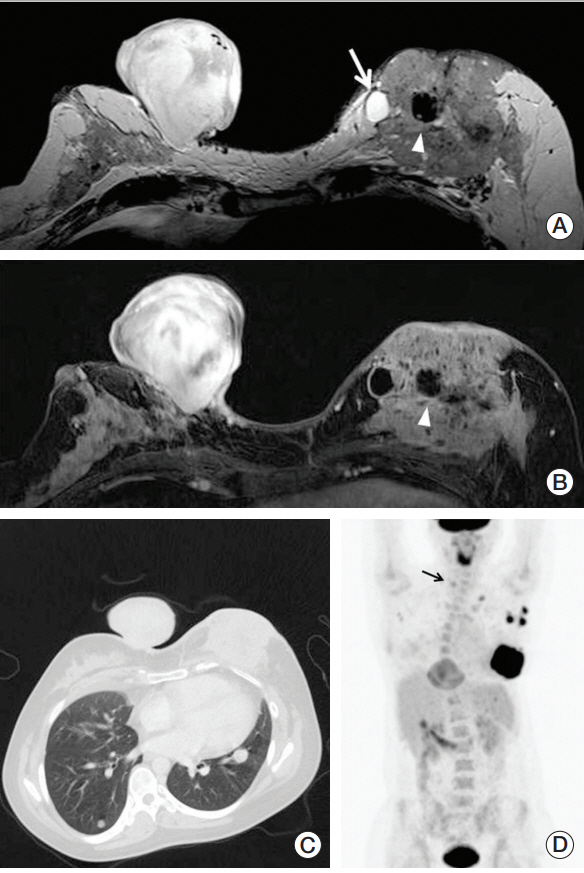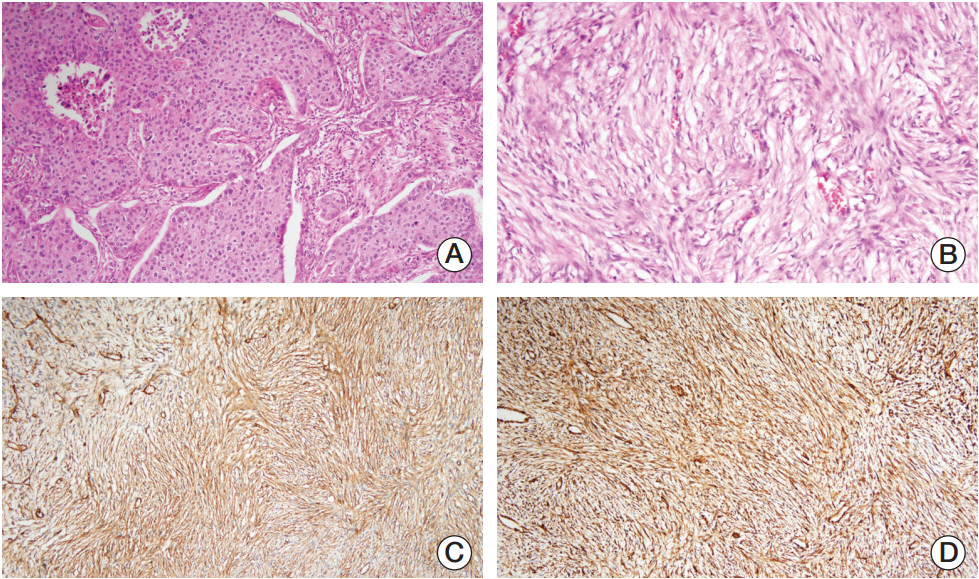Cancer Res Treat.
2019 Jan;51(1):402-407. 10.4143/crt.2017.579.
PTEN Mutation Identified in Patient Diagnosed with Simultaneous Multiple Cancers
- Affiliations
-
- 1Department of Internal Medicine, Uijeongbu St. Mary's Hospital, College of Medicine, The Catholic University of Korea, Uijeongbu, Korea.
- 2Department of Hospital Pathology, Uijeongbu St. Mary's Hospital, College of Medicine, The Catholic University of Korea, Uijeongbu, Korea.
- 3Department of Nuclear Medicine, Uijeongbu St. Mary's Hospital, College of Medicine, The Catholic University of Korea, Uijeongbu, Korea.
- 4Department of Radiology, Uijeongbu St. Mary's Hospital, College of Medicine, The Catholic University of Korea, Uijeongbu, Korea.
- 5Department of Radiation Oncology, Uijeongbu St. Mary's Hospital, College of Medicine, The Catholic University of Korea, Uijeongbu, Korea.
- 6Department of Surgery, Uijeongbu St. Mary's Hospital, College of Medicine, The Catholic University of Korea, Uijeongbu, Korea. drbreast@catholic.ac.kr
- KMID: 2437630
- DOI: http://doi.org/10.4143/crt.2017.579
Abstract
- PTEN hamartoma tumor syndrome is a spectrum of disorders characterized by unique phenotypic features including multiple hamartomas caused by mutations of the tumor suppressor gene PTEN. Cowden syndrome and Bannayan-Riley-Ruvalcaba syndrome are representative diseases, and both have several common clinical features and differences. Because PTEN mutations are associated with an increased risk of malignancy including breast, thyroid, endometrial, and renal cancers, cancer surveillance is an important element of disease management. We report a germline mutation of the PTEN (c.723dupT, exon 7) identified in a young woman with a simultaneous occurrence of breast cancer, dermatofibrosarcoma protuberans, and follicular neoplasm. This case suggests that it is critical for clinicians to recognize the phenotypic features associated with these syndromes to accurately diagnose them and provide preventive care.
MeSH Terms
Figure
Reference
-
References
1. Hobert JA, Eng C. PTEN hamartoma tumor syndrome: an overview. Genet Med. 2009; 11:687–94.
Article2. Pilarski R, Stephens JA, Noss R, Fisher JL, Prior TW. Predicting PTEN mutations: an evaluation of Cowden syndrome and Bannayan-Riley-Ruvalcaba syndrome clinical features. J Med Genet. 2011; 48:505–12.
Article3. Marsh DJ, Coulon V, Lunetta KL, Rocca-Serra P, Dahia PL, Zheng Z, et al. Mutation spectrum and genotype-phenotype analyses in Cowden disease and Bannayan-Zonana syndrome, two hamartoma syndromes with germline PTEN mutation. Hum Mol Genet. 1998; 7:507–15.
Article4. Bushby KM, Cole T, Matthews JN, Goodship JA. Centiles for adult head circumference. Arch Dis Child. 1992; 67:1286–7.
Article5. Eng C. PTEN: one gene, many syndromes. Hum Mutat. 2003; 22:183–98.
Article6. Yin Y, Shen WH. PTEN: a new guardian of the genome. Oncogene. 2008; 27:5443–53.
Article7. Marsh DJ, Kum JB, Lunetta KL, Bennett MJ, Gorlin RJ, Ahmed SF, et al. PTEN mutation spectrum and genotype-phenotype correlations in Bannayan-Riley-Ruvalcaba syndrome suggest a single entity with Cowden syndrome. Hum Mol Genet. 1999; 8:1461–72.
Article8. Lachlan KL, Lucassen AM, Bunyan D, Temple IK. Cowden syndrome and Bannayan Riley Ruvalcaba syndrome represent one condition with variable expression and age-related penetrance: results of a clinical study of PTEN mutation carriers. J Med Genet. 2007; 44:579–85.
Article9. Cheng H, Yang L, Xiong J, Peng J, Ruan Q. Multiple thyroid nodules in the lung: metastasis or ectopia? Diagn Pathol. 2015; 10:61.
Article10. Bubien V, Bonnet F, Brouste V, Hoppe S, Barouk-Simonet E, David A, et al. High cumulative risks of cancer in patients with PTEN hamartoma tumour syndrome. J Med Genet. 2013; 50:255–63.
- Full Text Links
- Actions
-
Cited
- CITED
-
- Close
- Share
- Similar articles
-
- Identification of a Novel p53 Intronic Mutation in Cowden's Disease
- Cowden Syndrome with a Novel Germline PTEN Mutation and an Unusual Clinical Course
- Bannayan-Riley-Ruvalcaba Syndrome in a Patient with a PTEN Mutation Identified by Chromosomal Microarray Analysis: A Case Report
- Loss of PTEN Expression in Breast Cancers
- Mutational and Loss of Heterozygosity Analysis of the p53 and PTEN Tumor Suppressor Genes in Breast Carcinoma





